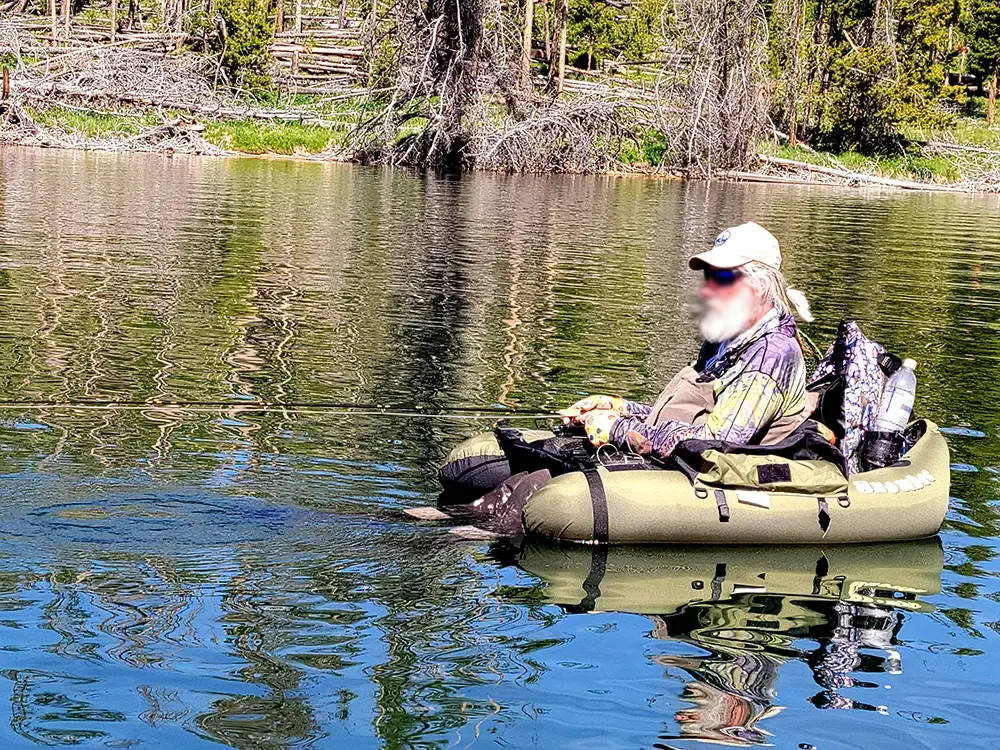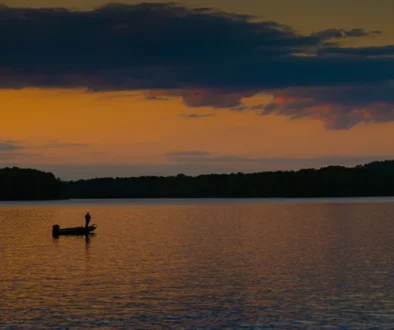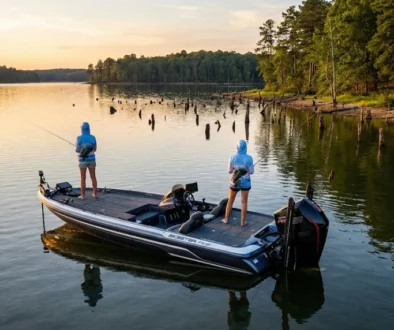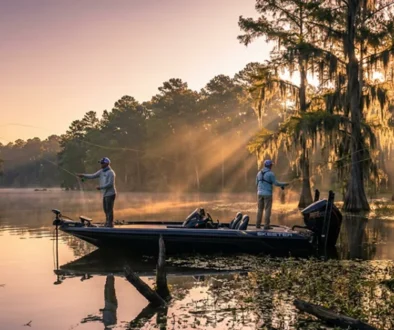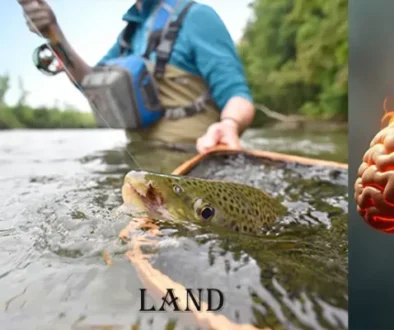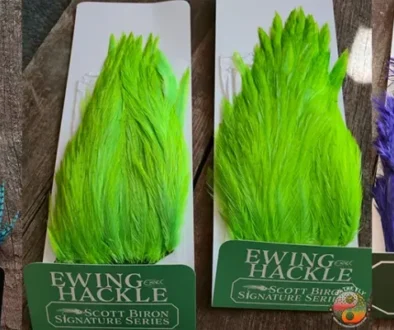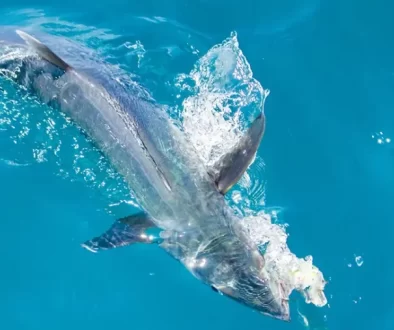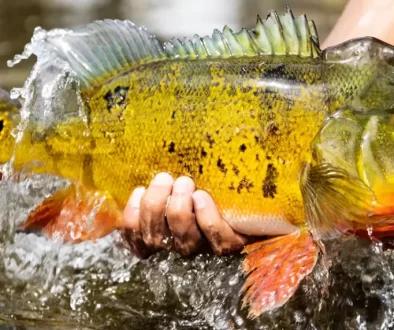Float Tube Fly Fishing: Tips to Enhance Your Fly Fishing Adventure
Float Tube Fly Fishing opens up a new world where you can glide into those hard-to-reach spots and snag the big one. It’s all about finesse, strategy, and of course, having the right gear. Today we’re diving deep into what makes this approach so rewarding.
You’ll get to grips with starting out in float tubes, keeping safe on the water, and packing your fishing necessities. We’ll tackle choosing fly rods that won’t let you down when that fish takes a bite and reels tough enough for lake trout.
And if weather changes or water bodies give you a challenge? No sweat—we’ve got techniques for that too. Stick around; it’s time to reel in some knowledge!
Float Tube Fly Fishing is the ultimate way to search stillwater effectively.
Float Tube Fly Fishing Essentials
If you’re eager to expand your fishing horizons, float tube fly fishing is like having a backstage pass to the water’s hidden corners. These inflatable thrones are not just great for sneaking up on unsuspecting fish; they give you access to spots that waders or shore-bound anglers can only dream about.
Getting Started with Float Tubes
Fishing from a float tube isn’t rocket science, but it does come with its own set of quirks. Think of your first date with a float tube: You’ll want to get familiar before making any big moves. Your vessel might be called many names—but at its core, it’s an inflatable chair that cradles you as you paddle around in search of the perfect spot.
A sturdy and reliable option like the Snowbee Classic V-Tube, known for enhancing fishing reach and maneuverability thanks to its teardrop shape, will help ensure those new relationships don’t go pop. Remember though—a fancy name doesn’t catch fish; understanding how these tubes operate does.
The beauty of these craft lies in their simplicity—the basic idea is floating comfortably while casting freely. So why pick something complex? A simple design means more time focusing on trout flies dancing across the surface rather than fiddling with gear—or worse—swimming back to shore because something went awry.
Prioritizing Safety on the Water
Safety should never take a backseat when you’re heading out onto open waters. Sure, getting tangled in Snowbee lines sounds more annoying than dangerous but add some unexpected weather changes into that mix and suddenly we’ve got ourselves quite an adventure—and not necessarily one we signed up for.
To stay safe out there among bigger fish lurking below or just beyond reach consider this: safety features are paramount so look for float tubes/belly boats equipped with ample storage space (for life jackets.), and enough load capacity so your stash of scientific anglers’ goodies won’t sink your ship before it sails.
Gear Checklist for Float Tubers
- Your trusty fly rod — length matters here folks since casting from seated positions demands shorter rods typically ranging between 9-10 feet.
- Durable reels — think along fly reel such as Spectre which holds up against salty adversaries without corroding quicker than your enthusiasm post missed strike indicators-small blips. Remember in a float tube your reel is going to be in the lake several times a day. A good sealed drag system is important.
- Variety of leaders including Snowbee Camo designed specifically keeping tube angling in mind ensure your fishing experience is top-notch.
Float tube fly fishing unlocks hidden spots and close-up action. Get a simple, sturdy float tube like the Snowbee Classic V-Float Tube for easy maneuvering. Keep it safe with essential gear: Longer rods, durable reels, and variety line packs.
Choosing Your Fly Fishing Equipment
Selecting the right gear can be as crucial to your float tube fly fishing success as the ability to read water or weather conditions. With a plethora of options out there, it’s like walking through a forest—knowing what trees make for good shelter can save you from getting soaked in a downpour.
Choosing the Right Fly Rod for Float Tube Fly Fishing
The rod is your sword in this watery battle; wield it wisely. When tube fishing, look for something that’s both an extension of your arm and sturdy enough to handle bigger fish that come calling. A shorter 8-10 foot rod might feel great because you won’t smack it against your float every other cast. But here’s where experience speaks: those extra few feet on an 9-foot Denny Rickards six weight is perfect. A ten foot fly rod will give you more leverage when casting from lower positions and help keep line off the water—a game-changer when aiming at super fat lake trout lurking below.
A balanced fly rod has enough backbone to toss streamers into gusty winds but also lets delicate dry flies land softly as feathers falling onto pillows—the kind of versatility needed when switching tactics on unpredictable waters. And always remember you can never have to many woolly buggers on hand.
Selecting the Ideal Fly Reel for Float Tube Fishing
Your reel isn’t just storing line—it’s keeping time with each heart-pounding run of big fish. You need a fly reel that pairs well with your chosen stick; think Fred Astaire and Ginger Rogers gliding across the dance floor seamlessly together—that’s how smooth we’re talking about here. Spectre Fly Reels is just that Fly Reel.
In float tubing scenarios, reels often get dunked (no surprise swims), so corrosion-resistant materials are not negotiable—they’re essential. Large arbor designs allow quick retrieves—an absolute must when trying to pick up slack before a crafty steelhead realizes he’s hooked and heads toward any logjam he can find.
Fly Lines and Accessories for Float Tube Fly Fishing
Sinking lines? Floating lines? Oh my. It feels like ordering coffee these days—you need specifics or else you’ll end up with something entirely wrong for taste… I mean, purpose. Sinking lines let anglers reach those depths where light rarely touches and monsters dwell; whereas floating lines suit surface strategies perfectly during hatch seasons making them indispensable companions alongside Snowbee Fluorocarbon leaders, priced kindly — while meeting sharper performance.
- If small bugs are hatching, match them using tiny offerings attached via Snowbee Como tippets—to avoid spooking finicky feeders;
- Tackle boxes filled with various weights will cover most situations one encounters on diverse water bodies;
- Sure, I can help you out. Could you please provide the paragraph that needs to be rewritten? Without it, I won’t be able to give you a revised version.
Float tube fly fishing gear matters as much as reading the water. Choose a rod that feels like part of your arm but still strong for big fish—like an 8 to 10-foot for leverage and line control. Pair it with a corrosion-resistant, large arbor reel for smooth action, crucial in unexpected swims. Don’t forget sinking lines to reach the deep dwellers or floating ones during hatch seasons, matched with affordable Maxima leaders and tippets to outsmart those tricky bites.
Advanced Techniques in Float Tube Angling
Float tube fly fishing isn’t just about kicking back and letting your line drift. It’s an art that, when mastered with specialized strategies, can seriously up your game and increase those catch rates on various bodies of water.
Effective Fly Fishing Techniques for Float Tube Fishing
You’ve got the basics down; now let’s tweak them to perfection. When you’re perched atop a float tube, your approach needs to be as fluid as the waters you’re navigating. Casting from this floating throne offers unique challenges but also distinct advantages. Imagine deploying strike indicators—small yet mighty sentinels—to alert you of even the most subtle nibbles beneath the surface. With these indicators finely tuned to fish behavior, studies have shown significant improvements in catch rates.
Fishing accessories like XS-Plus Fluorocarbon, known for its stealthy invisibility underwater can give you that edge by camouflaging with aquatic environments thus tricking wary lake trout into biting.
Targeting Lake Trout and Other Big Fish in Float Tube Fishing
Gone are days when big fish were only trophies on large boats’ walls. In a float tube, targeting hefty lake trout or other larger species becomes less of Moby Dick chase and more David versus Goliath—where odds favor agility over size. One technique is playing hide-and-seek with bigger fish using natural cover provided by water bodies’ teardrop sections which offer perfect ambush points for casting dry flies or streamers unnoticed.
A smart angler knows it’s not just about strength but strategy too; so incorporating rod holders into their setup lets them switch tactics seamlessly without losing precious time re-rigging gear because hey—a big one could bite any second.
Adapting to Weather Changes in Float Tube Fly Fishing
The sky above often mirrors what happens below: unpredictable weather changes dictate how prey move which means predators—and anglers—must adapt quickly if they want success stories rather than tall tales of ‘the one that got away’. Changing out fly lines may seem tedious while bobbing around mid-lake but doing so allows adaptation to sudden gusts or shifts helping keep casts accurate despite whims Mother Nature throws our way.
If storm clouds roll through, don’t despair—just swap over to Slow Sink Clear lines. They’re priced right and fit your budget, offering a low-visibility advantage under grey skies. This helps keep your fly in the water longer, increasing your chances against elusive swimmers lurking in the depths below. So wait out those rougher conditions until calm returns; then it’s time once again for bold adventurers to seek their next great catch.
Float tube fly fishing goes beyond casual casts; it’s a strategic sport where specialized techniques and gear like strike indicators and stealthy lines can boost your catch rate. By adapting to weather changes with the right accessories, even big fish in hidden spots become attainable prizes.
Maximizing Your Catch with Expert Tips
Fly fishing from a float tube isn’t just about kicking back and waiting for fish to bite. It’s an art that, when mastered, can lead you to some of the most exhilarating catches of your life. Let me tell you straight—using rod holders effectively or reading the subtle cues of fish movements can be game-changers in this water dance.
Strategic Use of Rod Holders
Rod holders might seem like a lazy angler’s accessory, but they’re actually tactical tools. By setting up multiple fly rods in these trusty sidekicks, you’re ready for any action that comes your way. Imagine spotting a lake trout lurking below—you’ll want your hands free to switch between dry fly setups or streamer rigs faster than it takes for that fish to change its mind.
The right setup means everything out here on the water where every second counts. You wouldn’t use maxima clear lines when chasing shadows through murky depths; ultragreen is your stealth weapon there. Keep both rigged and within arm’s reach because being prepared with options will make sure those elusive bigger fish don’t slip away into the blue unknown. I added this section for those that might be interested. I have never used a rod holder other than Velcro.
Tailoring Tactics to Fish Movement
To catch more than just weeds and water splashes, pay attention not only to what flies are at the end of your line but also how those underwater residents are behaving beneath you—not all fishing float tubes are created equal after all. Are they lazily drifting along? Or maybe darting quickly which indicates something has spooked them or perhaps they’re on the hunt themselves?
This is where things get interesting; let’s say Trout prefers cruising near teardrop-shaped sections by dawn—it’s time then for strategic positioning using silent trolling motors so as not be detected while closing in silently on our target zones armed with precision-tied tarpon flies (even if we’re aiming at lake trout).
Adapting Gear and Techniques To Weather Changes
Weather changes like mood swings—they’re inevitable and often unpredictable—but getting caught off guard doesn’t have mean defeat if equipped properly. As skies shift from sunny serenity into brooding storm clouds remember: adjust accordingly. Fly lines suited for gentler breezes won’t hold up against gusts capable turning calm waters chaotic so ensure replacements are handy within storage capacity limits without compromising safety features critical during sudden weather turns.
Snowbee Classic V-Tube, is renowned among seasoned anglers as sturdy crafts able withstand whims Mother Nature throws their way provide excellent load capacities allowing carry extras tackle boxes filled goodies may require should conditions flip script unexpectedly.
- Sometimes, things are kept under wraps for a reason. Whether it’s to protect information or maintain an element of surprise, secrecy can be crucial in certain situations.
Float tube fly fishing is more than a laid-back pastime; it’s a skill that, with savvy gear use and keen observation of fish behavior, can lead to thrilling catches. Master the art by being ready with varied rod setups and adapting your tactics to both fish movements and weather changes.
FAQs in Relation to Float Tube Fly Fishing
What is a float tube for fly fishing?
A float tube lets anglers stealthily slip into the water and snag fish that boats can’t reach.
Are float tubes worth it?
Totally. They give you access to remote waters and up your chances of landing that elusive catch.
Do you wear waders in a float tube?
You bet. Waders keep you dry and warm, turning hours on the water into comfy fishing time.
How do you get into a float tube?
To get started, just sit on the edge, slide your legs in, then kick off gently into the water.
Conclusion of Float Tube Fly Fishing
Float tube fly fishing takes you to the action, closer than ever. You’ve learned how float tubes can change your game, reaching spots full of promise. Safety first—always. Remember that.
Choosing gear is more art than science; pick rods and reels like they’re extensions of yourself. Let Maxima Ultragreen line be your stealthy ally in those elusive waters.
Tune into nature’s hints—the weather, the water’s mood—to outsmart even the wiliest lake trout with advanced techniques tailored for every ripple and wave.
Snowbee Classic Float Tube? That could be your vessel for victory on vast liquid arenas where big fish lurk beneath tranquil surfaces or dance through choppy waves.
To cap it off: expert tips are nuggets of wisdom ensuring each venture is not just a trip but an epic tale of angling adventure. Make them count because in float tube fly fishing, every detail matters—it’s about being smart as much as being there.
Beyond Float Tube Fly Fishing A World Awaits
Such as Fly Fishing Fortress Lake in British Columbia, or head to the Island of Iceland for an incredible experience. Into history do an Italian Fly Fishing Tour ending your journey on the island of Sardinia.

